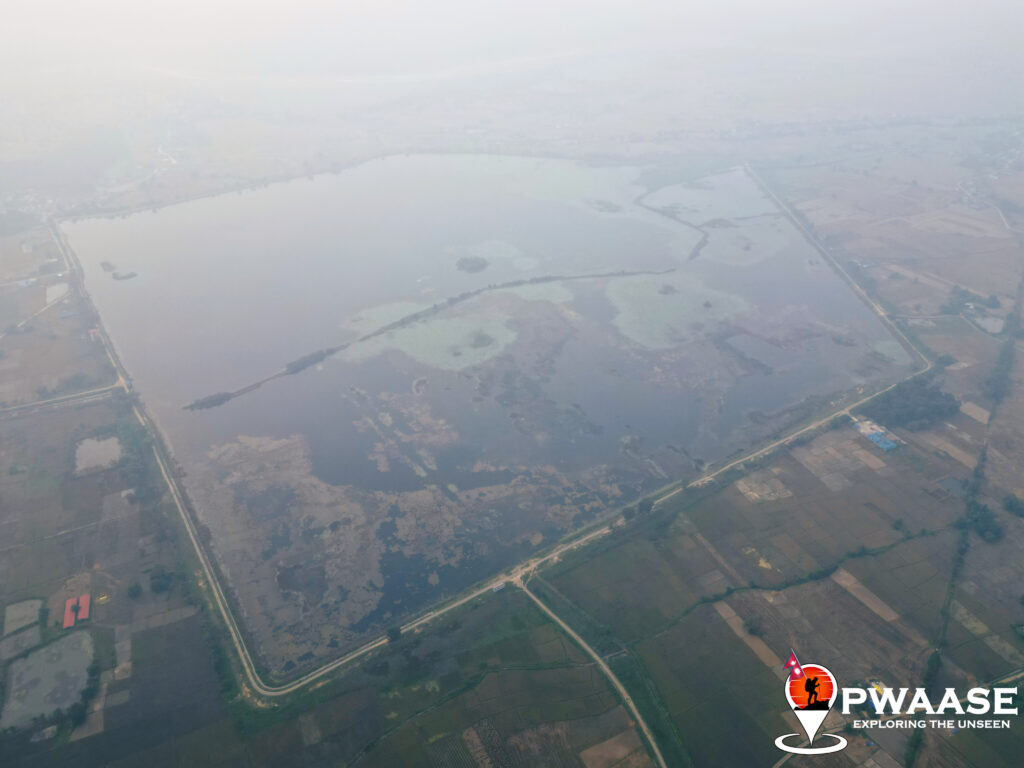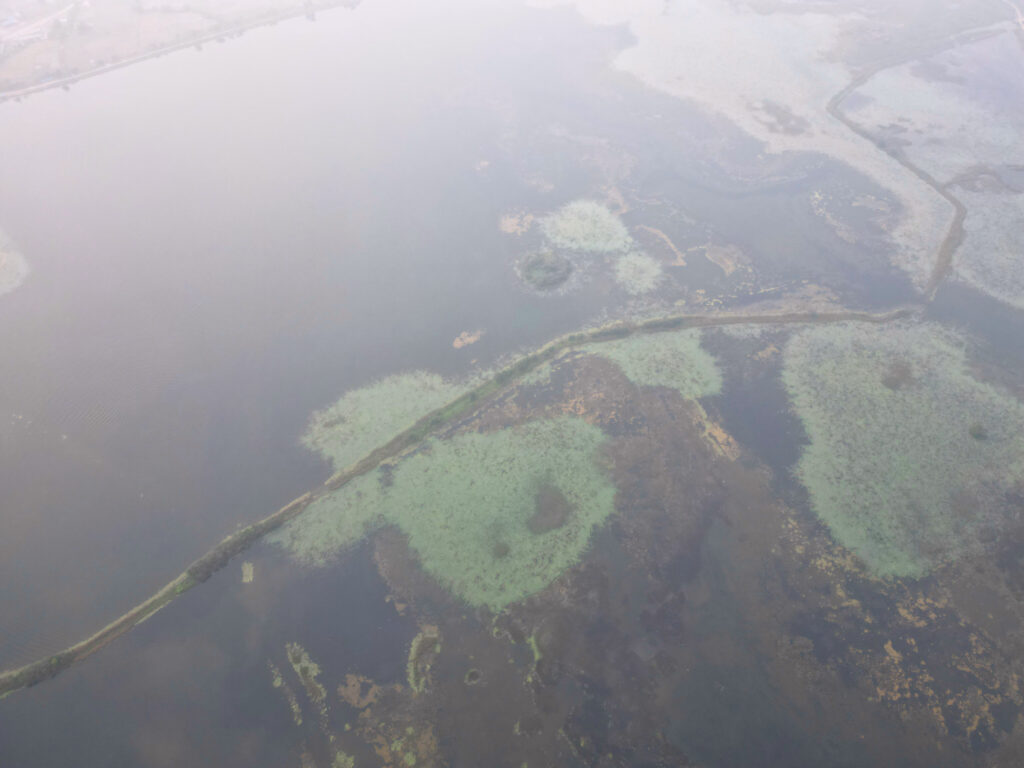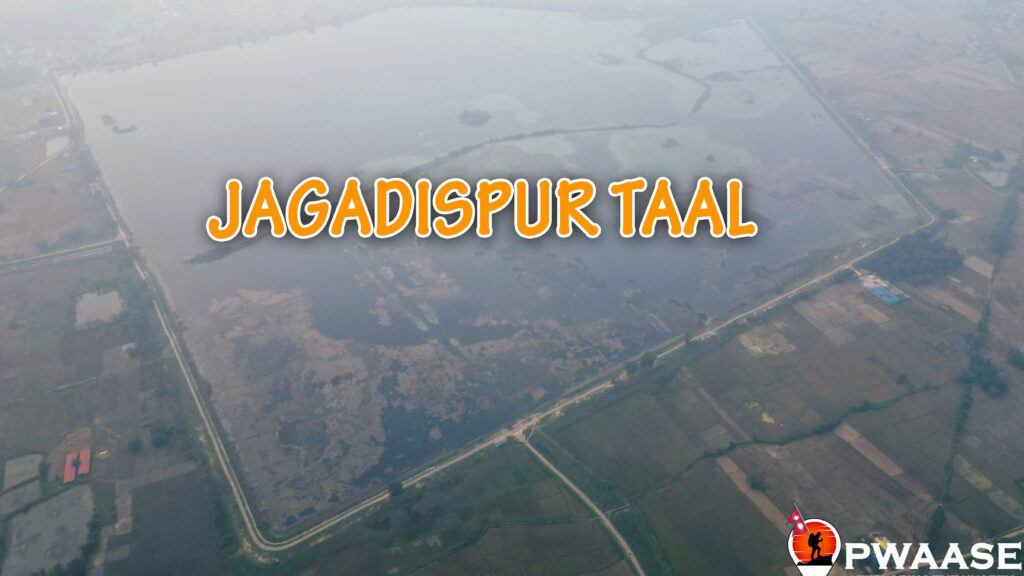Jagadispur Taal, located in the Kapilvastu district of Nepal, is one of the country’s largest reservoirs and a crucial wetland area of ecological, cultural, and agricultural significance which was named after Er. Jagadish Jha who designed and supervised the construction of Banaganga dam. It’s situated near the town of Taulihawa and is about 300 kilometers west of Kathmandu. Known for its rich biodiversity, scenic beauty, and historical context, Jagadispur Taal has become a prominent site for eco-tourism and wildlife conservation efforts in Nepal.

History and Cultural Significance
Jagadispur Taal, originally a small lake, was transformed into a larger reservoir in the early 1970s to support agricultural irrigation. Local lore and records indicate that it has long been an integral part of local life, especially for the indigenous Tharu people. Its creation was primarily driven by the need to support farming, yet it also has a spiritual place in the local community, with surrounding temples and cultural landmarks tied to the area’s ancient history.
The lake is situated near Lumbini, the birthplace of Buddha, which increases its significance for visitors interested in Nepal’s cultural and spiritual heritage.

Ecological Importance
Jagadispur Taal is designated as a Ramsar Wetland Site, recognized internationally for its ecological importance. The lake spans approximately 225 hectares and supports diverse flora and fauna, including several species that are rare or endangered. Birdwatchers are especially drawn to the site, as it is a major stopover point for migratory birds traveling between the Indian subcontinent and Central Asia. Over 200 bird species have been recorded here, including the sarus crane, which is the tallest flying bird in the world, as well as several species of storks, herons, and waterfowl.
Beyond bird life, Jagadispur Taal is home to various fish and amphibians that thrive in its ecosystem, providing a habitat for indigenous species and contributing to biodiversity in Nepal.

Biodiversity Conservation Efforts
Recognizing its importance, both local and international conservation organizations have focused efforts on preserving Jagadispur Taal. The Ramsar designation has brought attention and resources for wetland conservation, and initiatives have been taken to monitor and manage bird populations, water quality, and pollution control. Community-driven programs, including educational outreach, help raise awareness about the importance of preserving this ecosystem.

Eco-tourism and Community Involvement
Jagadispur Taal is increasingly popular among eco-tourists, who visit for birdwatching, photography, and peaceful interaction with nature. Local initiatives are in place to ensure tourism is sustainable and beneficial to the community. The site’s management involves local stakeholders, including the Tharu community, who help guide and protect the area. Tourism revenue has created job opportunities and improved infrastructure in nearby villages, supporting local development and conservation efforts.

How to Visit Jagadispur Taal
From Kathmandu, you can reach Jagadispur Taal by bus or a short domestic flight to Bhairahawa, followed by a road journey to Kapilvastu. The best times to visit are during the winter and spring months, when migratory birds are abundant. Tourists are advised to respect local guidelines for conserving the environment, including avoiding plastic waste and following marked trails.
TIL THAPA MAGAR
KAWASOTI-2, NAWALPUR NEPAL

Success starts with accurate information! Order data extraction and enhance your chances of growth. https://telegra.ph/Personalized-Contact-Data-Extraction-from-Google-Maps-10-03 (or telegram: @chamerion)
The art of data collection made easy! Order now and receive all the essential business contacts you need. https://telegra.ph/Personalized-Contact-Data-Extraction-from-Google-Maps-10-03 (or telegram: @chamerion)
магазин аккаунтов https://birzha-akkauntov-online.ru
купить аккаунт с прокачкой https://marketplace-akkauntov-top.ru
купить аккаунт продажа аккаунтов соцсетей
перепродажа аккаунтов гарантия при продаже аккаунтов
профиль с подписчиками https://prodat-akkaunt-online.ru/
аккаунт для рекламы https://kupit-akkaunt-top.ru/
профиль с подписчиками маркетплейс для реселлеров
Database of Accounts for Sale Online Account Store
Account Trading Accounts marketplace
Find Accounts for Sale Account Acquisition
Website for Selling Accounts Account marketplace
Ready-Made Accounts for Sale Sell accounts
Sell Account Account Selling Platform
Account Buying Service Account Purchase
Account Selling Service Sell Account
Secure Account Purchasing Platform Account Acquisition
Purchase Ready-Made Accounts Account market
Accounts marketplace Purchase Ready-Made Accounts
social media account marketplace account purchase
guaranteed accounts buy account
find accounts for sale account trading platform
account trading platform accounts marketplace
sell accounts buy pre-made account
account selling platform account selling platform
gaming account marketplace account trading platform
account selling platform accountsmarketdiscount.com
buy accounts secure account purchasing platform
buy and sell accounts sell account
account trading platform account market
ready-made accounts for sale https://buy-soc-accounts.org/
ready-made accounts for sale account catalog
accounts for sale sell pre-made account
guaranteed accounts account buying platform
find accounts for sale account market
account selling platform secure account sales
find accounts for sale gaming account marketplace
account market database of accounts for sale
secure account sales website for buying accounts
verified accounts for sale account sale
website for buying accounts secure account purchasing platform
buy pre-made account accounts for sale
marketplace for ready-made accounts website for buying accounts
ready-made accounts for sale verified accounts for sale
account market accounts market
accounts for sale account market
account market account market
account exchange https://accounts-offer.org
account trading https://accounts-marketplace.xyz
secure account purchasing platform https://buy-best-accounts.org
sell accounts https://accounts-marketplace.live
account sale https://social-accounts-marketplace.xyz
database of accounts for sale https://buy-accounts.space
accounts marketplace https://buy-accounts-shop.pro
social media account marketplace https://accounts-marketplace.art
purchase ready-made accounts https://social-accounts-marketplace.live
gaming account marketplace https://buy-accounts.live/
account trading https://accounts-marketplace.online
account selling service https://accounts-marketplace-best.pro
купить аккаунт akkaunty-na-prodazhu.pro
магазин аккаунтов https://rynok-akkauntov.top
продать аккаунт kupit-akkaunt.xyz
площадка для продажи аккаунтов https://akkaunt-magazin.online/
продажа аккаунтов akkaunty-market.live
площадка для продажи аккаунтов https://kupit-akkaunty-market.xyz
магазин аккаунтов akkaunty-optom.live
покупка аккаунтов online-akkaunty-magazin.xyz
маркетплейс аккаунтов https://akkaunty-dlya-prodazhi.pro
покупка аккаунтов kupit-akkaunt.online
buy ad account facebook https://buy-adsaccounts.work/
fb accounts for sale https://buy-ad-accounts.click
buy a facebook account buy facebook accounts
buying facebook accounts https://buy-ads-account.click
cheap facebook advertising account https://ad-account-buy.top
buy a facebook account buy fb account
buy account facebook ads https://ad-account-for-sale.top
buy aged facebook ads accounts https://ad-accounts-for-sale.work/
google ads agency account buy buy google ads agency account
google ads account seller https://buy-ads-accounts.click/
facebook ads accounts https://buy-accounts.click
buy google ads threshold account https://ads-account-for-sale.top/
buy google ads https://ads-account-buy.work
buy google adwords accounts https://buy-ads-invoice-account.top
google ads accounts for sale buy google ads invoice account
buy adwords account https://buy-ads-agency-account.top
buy account google ads https://sell-ads-account.click
google ads agency accounts https://buy-verified-ads-account.work
facebook verified business manager for sale buy facebook business managers
buy aged google ads account google ads accounts for sale
fb bussiness manager buy verified bm
buy facebook business manager account buy-bm-account.org
buy verified facebook business manager buy-verified-business-manager-account.org
buy facebook ads accounts and business managers facebook bm for sale
verified business manager for sale https://business-manager-for-sale.org/
facebook business manager account buy https://buy-business-manager-verified.org/
buy bm facebook https://buy-bm.org/
facebook business account for sale verified-business-manager-for-sale.org
facebook business manager buy buy-business-manager-accounts.org
buy tiktok ad account https://buy-tiktok-ads-account.org
buy tiktok business account https://tiktok-ads-account-buy.org
tiktok ad accounts https://tiktok-ads-account-for-sale.org
tiktok ads account buy https://tiktok-agency-account-for-sale.org
buy tiktok business account https://buy-tiktok-ad-account.org
buy tiktok ads accounts https://buy-tiktok-ads-accounts.org
tiktok ads account for sale https://buy-tiktok-business-account.org
buy tiktok ads https://buy-tiktok-ads.org
buy tiktok ad account https://tiktok-ads-agency-account.org
buy facebook accounts cheap profitable account sales account store
buy a facebook ad account buy pre-made account buy pre-made account
Pinco casino azerbaycan istifadəçiləri üçün lokal dəstək təqdim edir.
Pinco girişə dair heç bir çətinlik yoxdur pinco casino .
Ən maraqlı pinco oyunları burada təklif olunur.
Pinco casino azerbaycan platformasında böyük cekpotlar mövcuddur.
Pinco yukle və sevimli slot oyunlarını oynamağa başla.
Pinco oyunları hər zaman yenilənir və maraqlı qalır.
Pinco casino onlayn şans oyunlarının lideridir.
Pinco giriş zamanı heç bir problem yaşamazsınız.
Pinco promo code ilə daha çox bonus qazan [url=https://pinco-casino-azerbaijan-online.com/]pinco yukle[/url].